The Parable of the Prodigal Son is read on the second Sunday of the Triodion (the preparatory period before Great Lent), which is thus called Sunday of the Prodigal Son. The readings of the Church on both this and the following Sunday revolve around the central theme of repentance.
OUR MATERIAL
Terms of use
Please note: The copyright of our work belongs solely to Orthodox Pebbles. We are offering our material to the public to be used as a whole, and only for classroom and personal use. This means we do not allow for users to break our material up into individual parts (images or text), or to download decorative images from our website, and use those parts in their own creations – analog, digital, or online – even if these creations are only meant to be used for teaching. For example, a user is not permitted to include our material in any way in their own slideshows, worksheets or videos (local or in the “cloud”), even if they mention us as the source. If you are interested in creating a specific teaching activity with our material, please contact us – we may be able to create it instead, for the benefit of the whole Orthodox community. Additionally, if you want to showcase our material in a website, newsletter, blog or social media post, please contact us first. Finally, we kindly ask that you do not directly share the material you download from our website with others. Please point them to our website instead, so they can download it from here.
Thank you for being fair and respectful of our work!
FREE ANIMATION
FREE PRINTABLES
Sneak peek:
Printing problems? PLEASE CLICK HERE

Triodion Parables Learning Set
We have created a FABRIC LEARNING SET covering the parables of the Publican and the Pharisee and of the Prodigal Son, to help teach these topics in a hands-on way. It can be used together with the material on this page during the period of the Triodion.

TEACHING THE PARABLE
Main points

- God truly loves us, His children. When we commit sin, He is always ready to accept us back into His house, after we have sincerely repented.
- Humility is crucial in this process – true repentance brings about a humble heart which is then free to accept the love of God.
- Inside the Church, repentance and forgiveness are experienced through the Sacrament of Holy Confession.
Objectives
With the above main points in mind, objectives for a lesson targeting young children could be set up as follows.
Younger children should be able to:
- Briefly retell the parable story with the help of the icon or other visual aids.
- Point to the main characters in the icon – the Father and the prodigal son.
- Explain why, in the icon, the Father is hugging the son.
(The son is sorry for his wrong-doings and the Father is forgiving him because He loves him very much.) - State that, like the prodigal son, when we do something wrong, we should apologize.
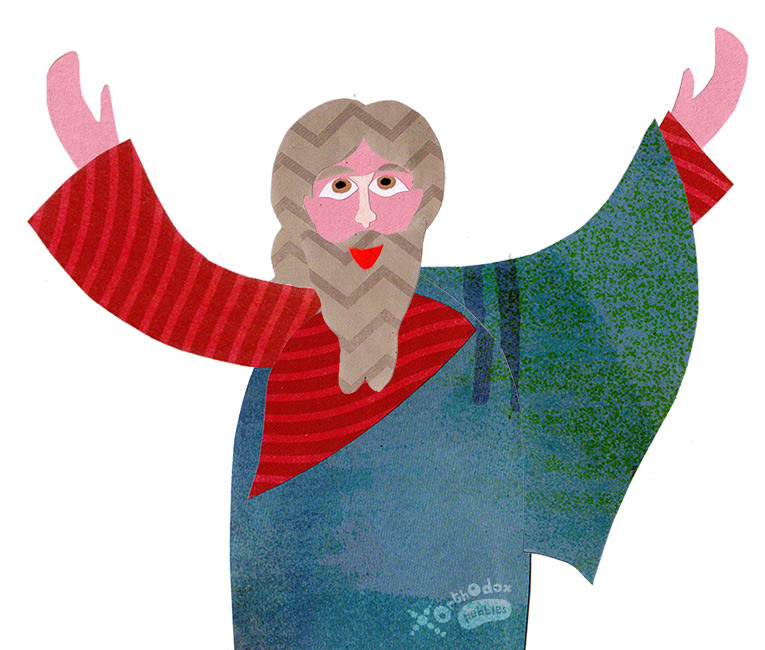
Additionally, older children should also be able to:
- Explain why in many icons the prodigal son’s father is depicted as Jesus Christ.
(The prodigal son’s father is actually Jesus Christ, and the son is each one of us who repents). - Describe the different scenes in the icon.
- Demonstrate understanding of the meaning of the word “repentance” when asked.
- Explain that, inside the Church, if we confess our wrong-doings to our priest (spiritual father), God is always ready to forgive and embrace us.
Planning the lesson
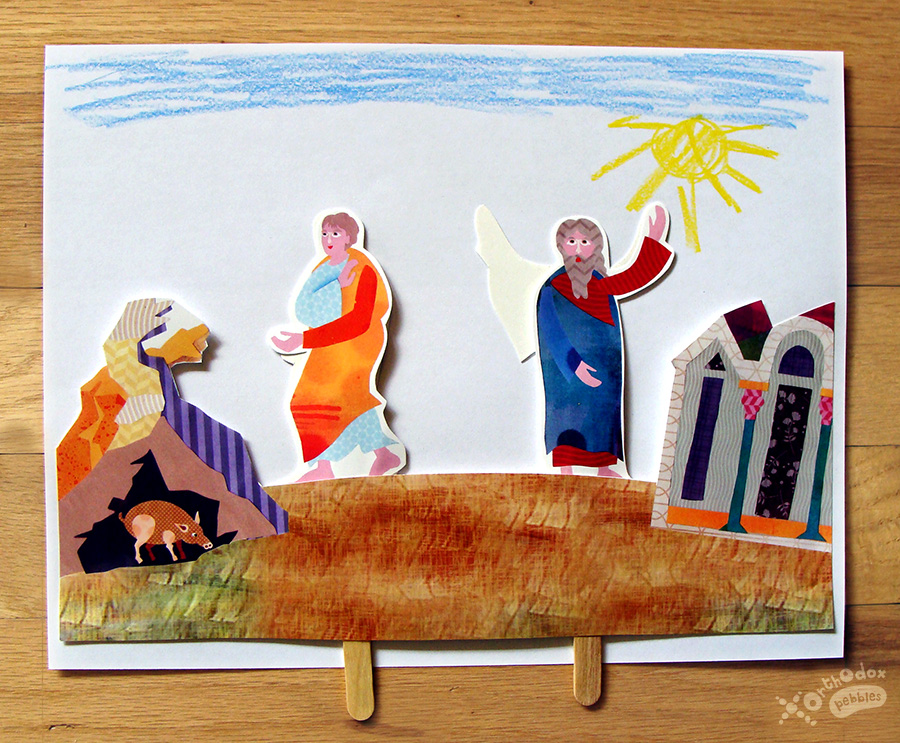
Using the resources offered on our webpage, a possible lesson outline could be as follows:
- Introduce the story, either using the animation video or the paper puppets.
- Discuss the main points.
- Explain the icon. We would use the simpler icon for the younger children and the more complicated one for the older ones.
- Do an icon worksheet. We offer two options, an easier and a more difficult one.
- Do a fun activity worksheet, which could be also given out as a home activity.
- Do the craft.
BACKGROUND
This is the third parable told by the Lord after the Pharisees had reproached Him for sitting and eating in the company of sinners. In this parable He is referring to the sinner who consciously chooses to sin (the Prodigal Son), and also to the one who does not want to repent (the brother).
Scripture reading
Gospel according to St Luke, chapter 15, verses 11-32.

The Story

The story is about a father and his two sons. The younger son asks his father for his share* of the inheritance and takes it. He goes in a far away place and lives wastefully, until there is nothing left from his inheritance. When he finds himself broke, alone, miserable and in need, he goes to work for a man who raises swine;** he is so hungry that he even craves the pig food. At some point he comes to his senses. He realizes what he lost at his father’s house, his pitiful situation and cries in repentance. Then he decides to return home to his father, asking him for forgiveness in the hopes that he will get a job as a servant.
He begins the long way back home. His father, who has been waiting for him, sees him from afar, runs*** to him, embraces and kisses him. He throws a big party to celebrate the return of his lost, and now found, son.
When the older brother, upon returning from the fields, finds out what is happening, he becomes envious and angrily reproaches his father. The father emphasizes that the older brother has always been enjoying what the paternal home has to offer, and, instead of being jealous, he should also celebrate for the return of his lost younger brother.
(Notes)

* At the time, the oldest son inherited two-thirds of the paternal property. The rest of the property would be divided among the other sons. It was a great insult and disrespect for a son to ask for his portion of the inheritance while his father was still living. The punishment of such a son, who would return to his paternal house, was severe: he would be beaten, or even stoned – in the best case, he would be treated as a servant and ordered to do the most lowly work.
** The swine were considered unclean animals by the Jewish people; the Mosaic Law forbade the Jews to either raise pigs or consume pork.
*** In the Jewish culture it was considered inappropriate for a father – an older man – to run. However, in the parable, the father did not wait for his son to come to him: instead, he ran to meet him. This self-humiliation indicates how intensely God will seek those who are lost in sin and alienated from Him.
Symbolism
On a first level, the father in the parable is God the Father, Who loves all humankind; the older son is the group of the righteous Jews (the Pharisees) who keep the Law of Moses and consider themselves as non-sinners; and the younger son represents the sinners with whom Christ is sitting and eating.
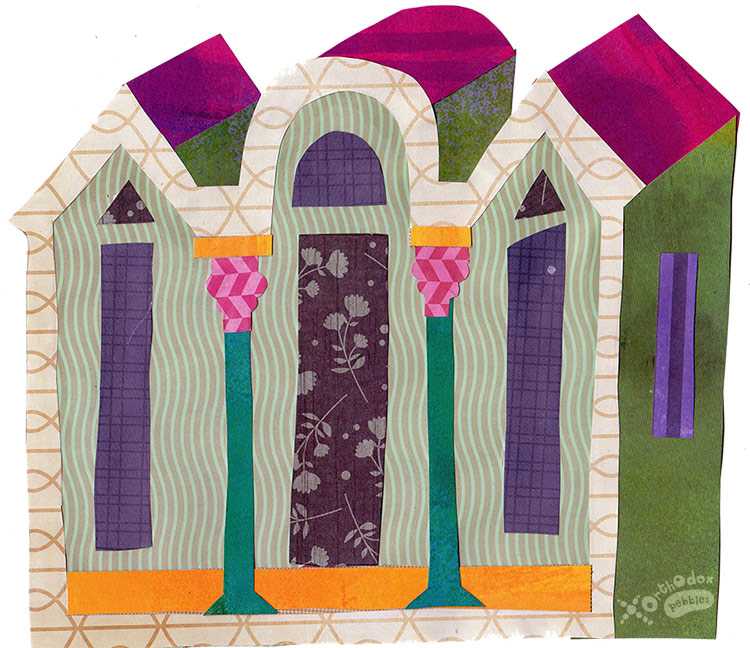
On a second level, the Holy Fathers of the Church have interpreted the story as follows:
- The Father: our Lord Jesus Christ, because He is the image of God.
- The Father’s House: the Church, the state of our union (communion) with God.
- The Younger son: the fallen humanity – all of us, who decide that true freedom is to go away from our Father’s House and do whatever we please.
- The Share of the inheritance: all the gifts than man receives from God, including his free will.
- The Far away place: our sinful state, our disconnection and alienation from God.
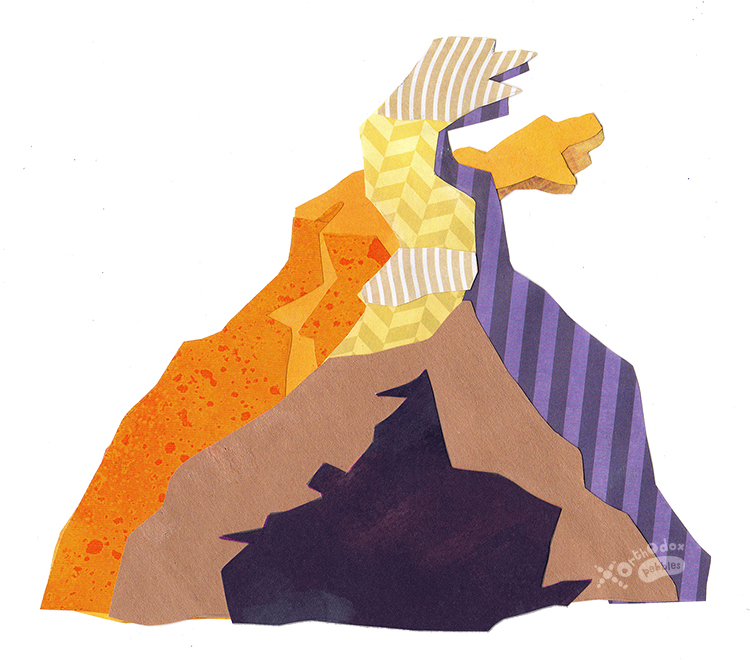
- The Farmer of the swine: the devil who tempts us to sin.
- Bread & hunger: Jesus Christ as the Bread in the Holy Eucharist; we hunger for the true happiness, the true life in God, which we find within the Church and Her mysteries.
- The Embrace: God’s mercy and forgiveness to the repentant humanity and its restoration as ‘His child’.
- The Robe: the Grace of God bestowed to man after Holy Baptism, and also after Holy Confession.
- The Ring: the gifts of the Holy Spirit given during Holy Chrismation; also, our restoration back to the Church after Holy Confession and the prayer of absolution.
- The Sandals: walking in our life according to the Gospel.
- The Fatted calf: the Holy Eucharist – our Lord Jesus Christ as the Sacrifice for the salvation of humanity.
- The Feast: the Divine Liturgy; the choirs of the angels and the Church, who rejoice for the return of a repentant sinner.
- The Older brother: A self-righteous, judgmental, entitled and envious person, he represents ourselves when we lack humility and love for our fellow men.
Icon Description
There are two main iconographic styles of the parable. In the first one, the father is depicted as an older man, with white hair and beard, whereas, in the second style, the father is clearly depicted as our Lord Jesus Christ.
There are many variations of the icon. Some focus only on the scene of the embrace between Father and younger son.
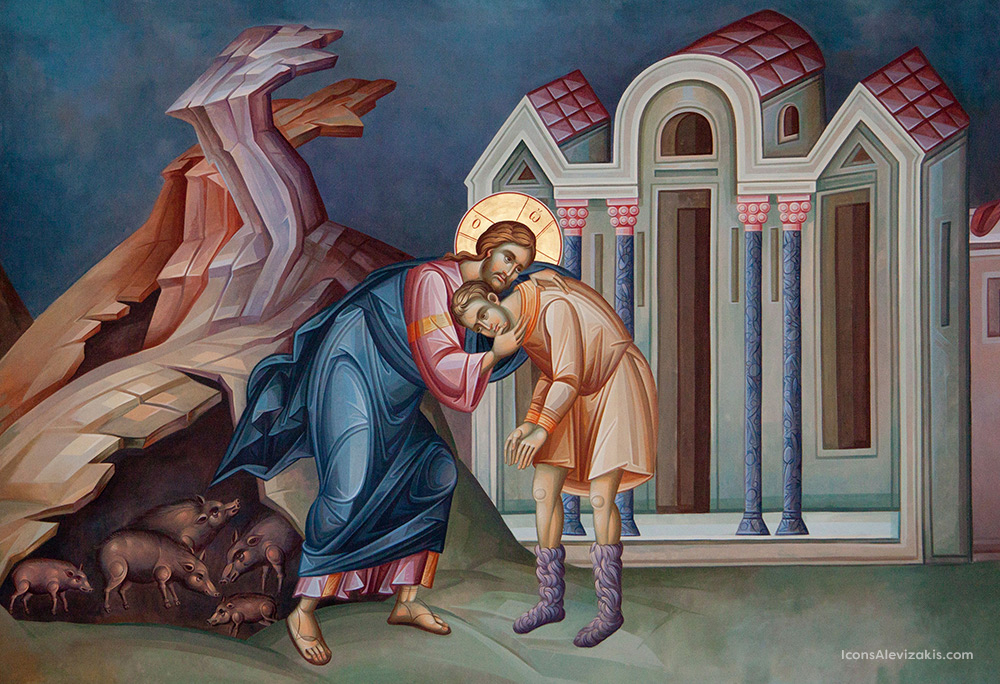
Wall painting by Michael Alevizakis, iconsalevizakis.com. St. Katherine Greek Orthodox Church, Little Falls, VA. Used with permission.
Other icons tell the whole story of the parable. In these versions, the embrace is the central element, usually depicted larger in size, while around it other scenes of the story are shown.

Icon by Athanasios Clark, tomclarkicons.com. Used with permission.
Possible scenes are:
- The departure of the younger son from his father’s house.
- The careless lifestyle of the younger son in the far away place.
- The younger son as a swine keeper, miserable and devestated.
- In some icons the pigs are black (sins) and in others we see the farmer of the swine (the devil), also dressed in black.
- The son walking back to his paternal house.
- The son kneeling down in repentance.
- The servants of the father’s house holding the festal robe, the ring and the sandals, to dress up the younger son for the celebration of his return.
- The fatted calf that is going to be slaughtered for the feast – a servant nears it holding a sharp knife.
- Musicians and people dancing at the feast celebrating the lost son’s return.
- The conversation between the father and the older son.
In some icons we can also see angels and other bodiless powers standing around an empty throne: that means that the Lord Jesus Christ descended from His heavenly Kingdom to meet, embrace, heal and restore the repentant humankind in the Kingdom.
Explore further
- Sunday of the Prodigal Son, article from the Greek Orthodox Archdiocese of America.
- The Prodigal Son from a far country, article by Fr Steven Kostoff, the Orthodox Church in America.
- Video of a Sermon on the Sunday of the Prodigal Son, by Metropolitan Kallistos Ware at Ss Constantine & Helen Greek Orthodox Church, Westland, Michigan.
- Podcast, Reflections on the Prodigal Son, Part 1 and Part 2, by Fr Thomas Hopko, on Ancient Faith Radio.
- Orthodox Study Bible, NKJV, by Thomas Nelson, Inc. Publishing House, 1982.
- Coffee with Sister Vassa video series, Episode 18, Publican & Pharisee / Prodigal Son (the Prodigal Son starts at minute 5:53).
Please note: We have had questions by some of our readers about using Sister Vassa’s videos in some of our pages. We understand that Sister Vassa supports some views that are considered controversial. The fact that we are sharing some of her videos doesn’t mean that we agree with the entirety of her online content. On the other hand, to the extent of our knowledge, we do find the specific videos in line with Orthodox teaching and helpful for discussing the specific topics.
Acknowledgements
Special thanks to Sister Vassa Larin for allowing us to embed her video in our webpage.
Scrapbooking paper used in the illustrations:
- The Paper Studio – Eclectic Remix 12″x12″
- The Paper Studio – The Basics 12″x12″
- Recollections multi-patterned paper pad 12″x12
- DCWV – Double Sided Cardstock Stack 12″x12″
- Colorbök – Spray Paint Cardstock 12″x12″
- Jane Davies – Collage Papers
- Pebbles – Front Porch 12″x12″


